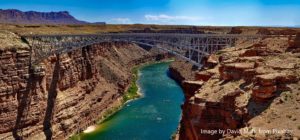Water Shortages and the Colorado River
- NPG
- September 22, 2021
- NPG Commentary
- 0 Comments
September 23, 2021
Water Shortage Declaration Good Start to Long-Standing Problem
 Last August, NPG discussed the precarious state of the Colorado River in an email to members and supporters. A year later, on August 16, 2021, the Bureau of Reclamation officially declared a water shortage on the historic waterway. This water shortage produces many environmental problems, such as extended drought, wildfires, extreme temperatures, flooding, and landslides. Additionally, human inaction in the political realm has also impeded a fair systemic reduction of water distribution that prioritizes the health and maintenance of the Colorado River, a vital and integral part of the West’s ecosystem.
Last August, NPG discussed the precarious state of the Colorado River in an email to members and supporters. A year later, on August 16, 2021, the Bureau of Reclamation officially declared a water shortage on the historic waterway. This water shortage produces many environmental problems, such as extended drought, wildfires, extreme temperatures, flooding, and landslides. Additionally, human inaction in the political realm has also impeded a fair systemic reduction of water distribution that prioritizes the health and maintenance of the Colorado River, a vital and integral part of the West’s ecosystem.
A recent article, published by Slate, transcribes an interview between journalist Lizzy O’Leary and Abrahm Lustgarten, a senior investigative reporter for ProPublica. When asked if this water shortage was predictable, Lustgarten, who focuses on the environment in his work, said: “On one hand, climate change’s impacts on the river are surprising: They’re coming faster, and they’re having a greater impact than some people expected. But on the other hand, the river has been in trouble for a long, long time, and that’s not a surprise to the people who watch it closely.” In other words, for folks paying attention – this declaration was a long time coming.
The interview covers many salient points, from the original 1922 Colorado River Compact agreement (CRC) to today, 100 years later. The agreement between seven neighboring states (Arizona, California, Colorado, New Mexico, Nevada, Utah, & Wyoming) used limited data to estimate how much water was available and then divided that amount by state needs. As decades fluttered by, new data emerged, and the population boomed, but the agreement remained unchanged. In 2007, leadership from each state got together to discuss the Colorado River. When the group met, they decided to acknowledge that there was absolutely cause for concern, and, at that point, they also agreed to reconvene should the situation become dire. Fast forward to 2019, when the agreement was amended to include how much water each state would lose if there was a water shortage declaration.
When asked who relies on the river system, Lustgarten replies: “Forty million Americans, give or take, depend on water from the Colorado River. But that water is also used to irrigate farms that provide an incredible proportion of the fruits and vegetables that get shipped around the country, as well as feed for the cattle that is a really substantial portion of the meat consumed by Americans. In addition to that, the water is routed outside of the Colorado River basin to the city of Phoenix, the cities of Los Angeles and San Diego and Denver, none of which are in the natural geography of the Colorado River.” With these staggering facts clearly illustrating the over-share of the river’s water across many state lines and the reliance on an archaic agreement, it is nothing short of a miracle that the Colorado River has sustained its flow for as long as it has.
Changes are necessary to help stabilize the Colorado River. Charted 150 years ago by John Wesley Powell, the river has witnessed many changes, such as the construction of three dams, population growth, and agricultural development. Along with these changes, efforts should have been made to acknowledge and address the effects of constant population growth in the region – which would have (ideally) led to amending the Colorado River Compact agreement much sooner.
NPG takes the threat to the Colorado River and other waterways of its kind very seriously. Soaring population numbers, especially in the West, must be circumvented to curb further shared use of the river before it is too late. As Michael Hanauer states in his May 2020 NPG Forum paper: “Population growth is crucial in its impact on virtually every problem we face, and in its major impact in ever reaching authentic sustainability. Stopping and then reversing population growth is a necessary part of the sustainability equation. Environmental organizations and individuals need to incorporate the population connection into their program.” The bottom line is that it is not sustainable for the river to provide freshwater to millions of people and all regional farmland. It has not been sustainable for a very long time.
For more reading, please see our Forum paper series, notably:
The True Environmental Disaster – The Silence on Our Growing Overpopulation – by Michael G. Hanauer
Population Threats to America’s Rivers, Estuaries, and Lakes – by Christopher Daly
Help us continue to release information such as this by making a donation today!
| [WD_Button id=18412] |
